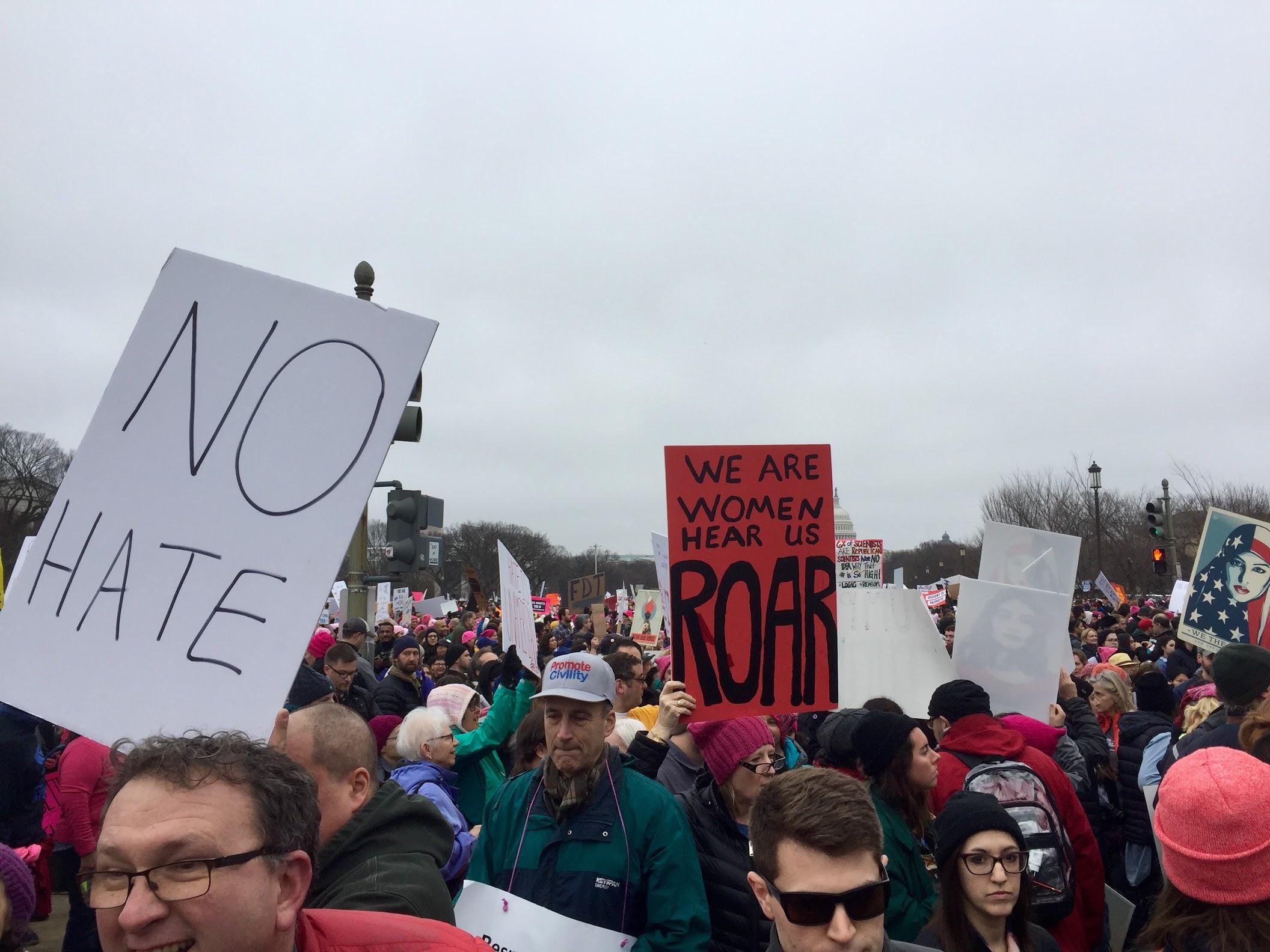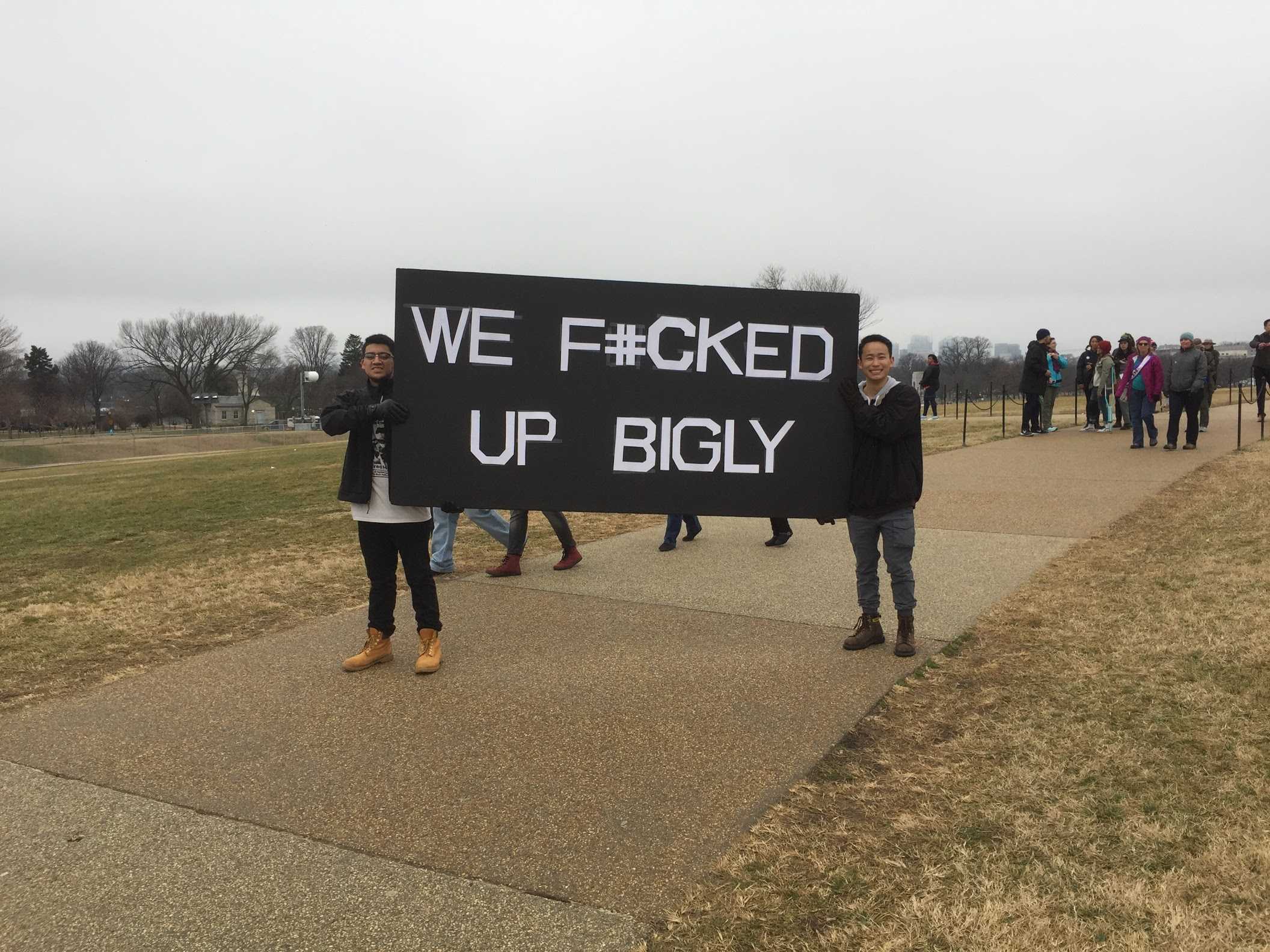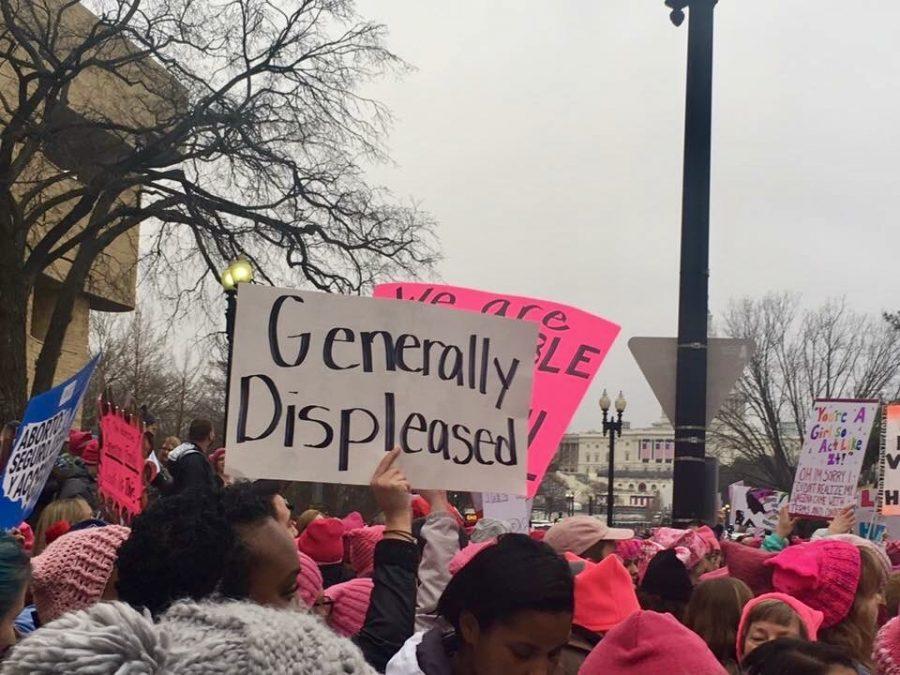Aftermath
February 1, 2017
A Journal by John Hydrisko, Photos by Julia McDowell
Friday, 20 January 2017, 11:59 a.m. | SEPTA R5 to Jefferson Station
I watch the inauguration of Donald Trump on my girlfriend’s iPhone. For a lack of headphones—and because this is the quiet car—we view the livestream without sound. I don’t think I’m missing much. I see him mouth the Oath of Office, parroting it from Chief Justice Roberts. Julia and I begin to watch the inaugural address. I find it especially easy to read two words on the President’s lips: America and I.
It’s surreal. The address is only gesture, with me filling in whatever I want or expect to hear. The thirty million Americans watching with the benefit of sound are doing the same thing.
We lost the signal as the train coasted underground.
Friday, 20 January 2017, 3:25 p.m. | Greyhound Bus Terminal, Baltimore
As new passengers shuffle down the aisle, I think about the last ten minutes. The bus trundling out of the harbor tunnel. The hulls of gutted Navy ships moored at the wharf. The vacant printing plant labeled The Baltimore Sun in peeling block letters. The expanse of poor neighborhoods spreading out beneath the overpasses. My mind drifts to more distant images of Baltimore. A helicopter’s view of brown-grey smoke sliding out of a CVS pharmacy. Police cars burning in broad daylight. These were the results of the protests/riots after Freddie Gray died in April, 2015.
A jaunty sentence works its way into my head, a fragment of Countee Cullen’s “Incident.” The 1925 poem is a memory from early childhood—his first taste of American racism, a flavor of hate I will never have to know.
“I saw the whole of Baltimore from May until December; of all the things that happened there that’s all that I remember.”
Friday, 20 January, 2017, 3:47 p.m. | Mile 27, Baltimore-Washington Parkway (Southbound)
I’d guess that half the people on this bus are headed to the Women’s March. Some of them have signs and posters and buttons and t-shirts.
As someone who follows political news and holds opinions on political issues, it seems odd that I’ve never been to a political assembly before. I understand the value of rallies and protest, but I’ve never assembled for or against anything or anyone.
Of course, I left my red necktie at home, but I don’t own any of the paraphernalia of a prototypical protestor. I told this to some of my more liberal friends, who were eager in their charity: one Radnor senior offered me a F**K TRUMP shirt; a junior offered me a F**K TRUMP button. I thanked them both, but declined.
Friday, 20 January 2017, 4:55 p.m. | Union Station, East End
The city is in a condition of simultaneous movement and stagnation like the northward tide of the Chesapeake rising to meet the southward flow of the Potomac. Trump’s supporters spill out of the Metro and taxis while his detractors file off of Amtrak trains and Greyhound buses. In an ideologically brackish area the two groups commingle, and it’s more difficult to categorize individuals than one might expect. A burly man wears a camouflage hunting jacket adorned with LOVE WINS buttons. A young, seemingly suburban woman wears a shirt reminding us that HILLARY SUCKS BUT NOT LIKE MONICA.
Friday, 20 January 2017, 5:13 p.m. | 4½ and K, Downtown
The Uber cuts left onto K Street, narrowly missing a green Humvee parked on the corner. The District is secured by a quilt of Metropolitan police, National guardsmen, and US soldiers, and much of Downtown is closed to civilian traffic.
The radio carries reports of violence the night before: windows were smashed at a Starbucks, a Bank of America; a limousine was set afire. The protesters are being held on federal rioting charges and face a $25,000 fine and up to ten years in prison. A self-proclaimed liberal calls in to comment on the legal action. She says, “Free them all. No charges. No state intimidation.” I’m not sure if I can agree with her.
I ask the driver how the day was.
“Crazy, yes, but…good crazy,” he says with an accent.
“Good crazy?”
There’s a Nigerian flag on the dashboard.
“Yes. I had many fares today.”
Using the touchscreen on the dashboard, the driver swipes between two radio stations. He plays ten seconds of FoxNews and then another ten of NPR.
“Do you have a preference?” he says.
Friday, 20 January 2017, 8:41 p.m. | The Lincoln Memorial
After a dinner at Whole Foods, Nicole and I find ourselves here. The Memorial is still closed after an inaugural concert the night before. A temporary stage covers the main stairs; scaffolding climbs up towards the entablature; industrial sound systems flank the colonnade. Under halogen lights, a few dozen workers take down the temporary structure. They work quickly and make little noise. From where we sit it looks like a timelapse as the aluminum falls away from the marble.
Since his dedication in 1922, this statue of Abraham Lincoln has witnessed twenty-three inaugurations at the U.S. Capitol; in almost a century, he’s seen twenty-three inaugural addresses. I know that Lincoln’s second inaugural address is inscribed within the Memorial.
I smell marijuana smoke from near the Vietnam Veterans Memorial and try to remember how the last sentence starts. I think I’ve got it: “With malice toward none, with charity for all…” Yes, I remember that much.
With malice toward none, with charity for all, with firmness in the right as God gives us to see the right, let us strive on to finish the work we are in, to bind up the nation’s wounds, to care for him who shall have borne the battle and for his widow and his orphan, to do all which may achieve and cherish a just and lasting peace among ourselves and with all nations.
Less than nine hours ago, the statue of Abraham Lincoln watched Donald Trump take the Oath of Office with his hand on Abraham Lincoln’s bible. With malice towards none. With charity for all.
Friday, 20 January 2017, 9:03 p.m. | The Washington Monument
The Republican says, “If Washington were alive, he’d be a Republican.”
The Democrat says, “If Washington were alive, he’d be a Democrat.”
If Washington were alive, I think to myself, he’d smack both of them.
Friday, 20 January 2017, 10:13 p.m. | 33rd and M, Georgetown
Sometimes I find myself looking at people on the street in a not-so-inconspicuous way. Here, on this street corner, I find myself looking at a man in the passenger seat of an Escalade not fifteen feet in front of me. He’s in his mid-forties with dark hair and a complexion not native to this latitude. He’s wearing a tuxedo, presumably on his way to one of the inaugural balls. He’s relaxed, with the window down and his forearm propped along the windowsill. He’s very handsome when he smiles. He’s the spitting image of Marco Rubio.
“Holy shit,” someone says, “that’s Marco Rubio.”
Friday, 20 January 2017, 10:14 p.m. | 33rd and M, Georgetown
A minute has passed. Marco Rubio—the former favorite for the Republican presidential nomination—is still stopped at a red light. He’s smiling at me and the other pedestrians.
One man says, “I know you!”
Senator Rubio says, “Well I know you, too!”
I hear a bustle behind me; it’s centered on a woman. She’s probably fifty. She’s wearing a beige coat over a black jacket. She’s probably Jewish. She’s shorter than she should be. She’s definitely Jewish—she’s Florida’s first Jewish congresswoman. She’s my least favorite Democrat. Until late July, she was the Chair of the Democratic National Committee.
“Holy shit,” someone says, “that’s Debbie Wasserman Schultz.”
Friday, 20 January 2017, 10:58 p.m. | Ninth Floor, Mark Shenkman Hall, The George Washington University, Foggy Bottom
The four of us sit in the living room of an apartment-style dorm. I’m studying for an AP Government and Politics midterm, highlighting a thick review packet. Bobby—from the University of Delaware—flips through Netflix titles on the small TV, stopping on the title screen for House of Cards. Julia scrolls through Instagram, tapping at pictures of her friends preparing for the Women’s March in either Philadelphia or Washington. Nicole—the one who actually lives here—holds a BERNIE 2016 mug in her free hand, filled with Wild Turkey.
The dorm is about a hundred feet above Virginia Avenue NW, which the National Guard has closed. At the sound of sirens, I walk over to the widow and stick my head outside. I look down at the motorcade as it comes into view. Four Metro motorcycles; three Metro cruisers; a black SUV; three heavy black limousines with American flags; a black SUV with the rear hatch open; a black SUV with domes and antennae on the roof; a black limousine; three more black SUVs with rear hatches open; a black sedan; a blacked-out ambulance; four Metro motorcycles; three Metro cruisers. At the sound of rotor blades, I looked up into the spotlight of a US Coast Guard helicopter. The whole procession maintained uniform spacing, spanned about two blocks, and passed in under a minute. I returned to my seat.
“Was there an ambulance?” Nicole says.
“Yes.”
“Then it’s the President.”
She took a long drink.
I looked down at my review packet for AP Gov and read some of the terms: incorporation doctrine, Korematsu v. United States, the Equal Protection Clause, the Twenty-fourth Amendment to the United States Constitution. I doubt Donald Trump could explain a single one.
I looked up at the television, right at Kevin Spacey, and could almost hear President Underwood say, “We get the leaders we deserve.”
Saturday, 21 January 2017, 11:16 a.m. | Lower Gallery, Smithsonian Institution Building, National Mall
As much as it pains me, Julia hates museums. (She finds them boring and slow and somewhat pretentious.) But the Smithsonian Castle isn’t a museum right now; it’s a refuge. The gallery is packed with protesters from the Women’s March, including ourselves. I can see about three hundred people from where I’m sitting, and security is overwhelmed—five guards rush around with acrylic wands, inspecting random handbags and backpacks. They yell that visitors cannot have signs or posters in the museum. Neither of us have one.
We’re standing next to a couple in their early fifties.
The wife says, “Not many men here, sweetheart.”
The husband says, “I’d say only one in twenty people is a man,”
The wife says, “Gosh, sweetheart, maybe even less.”
They were looking at the long line for the women’s restroom.
Saturday, 21 January 2017, 11:46 a.m. | Starbucks, 1201 Maryland Avenue SW, Waterfront
It should have taken us ten minutes to walk the half mile from the Smithsonian Castle. Instead, Julia and I take half an hour to push past thousands of people. (The New York Times would later cite crowd scientists’ estimate of at least 470,000 people present on or near the Mall at the time.)
By some miracle, the Starbucks is mostly filled with people waiting to use a restroom. She drinks coffee, I drink tea, and we split a croissant, basking in our temporary status as independent metropolitans. I take a moment to look around and jot down a sampling of the people in the coffee-shop:
- Four high-school aged girls in matching pink baseball caps drinking Frappuccinos out of season
- A single father and his five-year-old (still perched on Dad’s shoulders) eating a breakfast sandwich and a cake pop, respectively
- A perpetually smiling person in their twenties wearing a large button requesting the use of THEY, THEM, THERE pronouns and sipping green tea
- A tall, Black woman in a white t-shirt with a portrait of Malcolm X across the front; her right hand holds a neatly lettered sign demanding FREEDOM BY ANY MEANS NECESSARY! and her left hand holds a hot chocolate
- A young Muslim woman wears a lavender hijab and shares a turkey-pesto sandwich with her friend, a Christian who wears a silver crucifix and a canary hijab in solidarity
- An elderly couple in LOVE TRUMPS HATE shirts drinking small black coffees
- An Asian student wearing jeans and a Vineyard Vines quarter-zip embroidered with Georgetown University’s Jack the Bulldog; she’s drinking quickly from a 12 fl. oz. Red Bull and has co-opted the DON’T TREAD ON ME flag.
- A compatriot—a middle-aged Unitarian Universalist (wearing our signature yellow STANDING ON THE SIDE OF LOVE shirt)—eating organic popcorn with glee; before we leave the shop, he hands me a one-page printed excerpt from The Communist Manifesto
Saturday, 21 January 2017, 12:00 p.m. | At 12th and C, looking west towards 14th and C
Very briefly, and from afar, I see a person with a bandanna on his face who has climbed atop a streetlight. People around him are watching, too. He pulls an American flag from his backpack. It burns quickly.
Saturday, 21 January 2017, 12:14 p.m. | Jefferson Dr. SW, National Mall
I cannot know what will be said about these hundreds of thousands of protesters. I do not even know if I should count myself as one of them. I agree with the platform of the Women’s March. I share political opinions with much of these people. I’m here in solidarity with all of them.
In most conceivable ways, I am a very privileged person. I’m a straight, white, cis-gendered, male, United States citizen; I’m not a Christian, but my religious status has never brought me harassment or exclusion or persecution. My only status of disadvantage might be my socioeconomic class, but I’m receiving an excellent education and live in an excellent area and (for the moment) have excellent access to healthcare. Today isn’t about me, and I’m okay with that.

Saturday, 21 January 2017, 12:23 p.m. | The Washington Monument
We see the sign at two-hundred yards.
“That’s our favorite,” she says.
“No doubt,” I say.
The two men carrying the sign begin to move, and we have to run after them to take a photograph.

Saturday, 21 January 2017, 4:18 p.m. | Ninth Floor, Mark Shenkman Hall, The George Washington University, Foggy Bottom
A Text Conversation
dude
What’s up?
ive been thinkign
About what?
the List of republicans i respect
its
dwindling
Oh?
What’s the list?
it starts with john mccain
actually it also ends with john mccain
Saturday, 21 January 2017, 7:13 p.m. | US Department of State, 23rd NW, Foggy Bottom
The Harry S. Truman Building is massive. We’re walking on the sidewalk, past the block of concrete and blast-resistant windows. The pavement takes us within fifteen feet of the guardhouse; inside are two members of Diplomatic Security, each with an M4 across his chest. I smile at them, and one guard nods.
Saturday, 21 January, 2017, 10:49 p.m. | City View Room, atop the Elliott School of International Affairs, Executive District
I’m wearing a blue suit and a white shirt without a tie, and I feel cold out here on the roof deck taking a break from the party inside. I’m usually afraid of heights, but I lean against the railing. The view is sweeping. To the west, across the Potomac, I can see the towers at Rosslyn, Virginia. To the south is the Washington Monument, its upper third unseen behind a low, dense fog. To the southeast is the dome of the Capitol. To the east is a cloud of bright, bluish light that hovers around the White House.
The White House—in the abstract—used to feel like it belonged to everyone. But when I saw it earlier today, it looked small.
Julia leads me back inside to take pictures with cardboard cutouts of Barack Obama and Joe Biden.
Saturday, 21 January, 2017, 11:59 p.m. | Lincoln Memorial
A National Parks Ranger yells at us for dangling from the last of the scaffolding.
“You made a giant jungle gym,” Bobby says to no one. “Well I’m gonna play on it.”
Still, we leave the memorial. The three of us meander past the now-closed gift shop, talking loudly. I notice that someone has carved M.A.G.A. into the shop’s wooden wall. Make America Great Again.
Make America great again.
In 1935—from within the Great Depression—Harlem’s poet laureate Langston Hughes wrote a poem that ends like this:
O, let America be America again—
The land that never has been yet—
And yet must be—the land where every man is free.
The land that’s mine—the poor man’s, Indian’s, Negro’s, ME—
Who made America,
Whose sweat and blood, whose faith and pain,
Whose hand at the foundry, whose plow in the rain,
Must bring back our mighty dream again.







